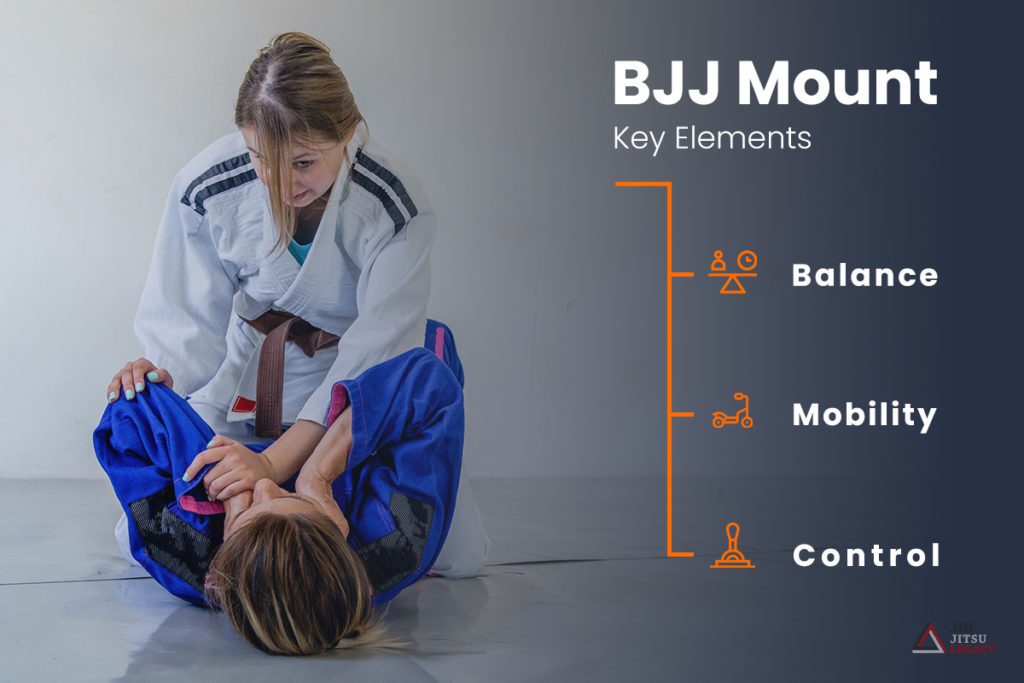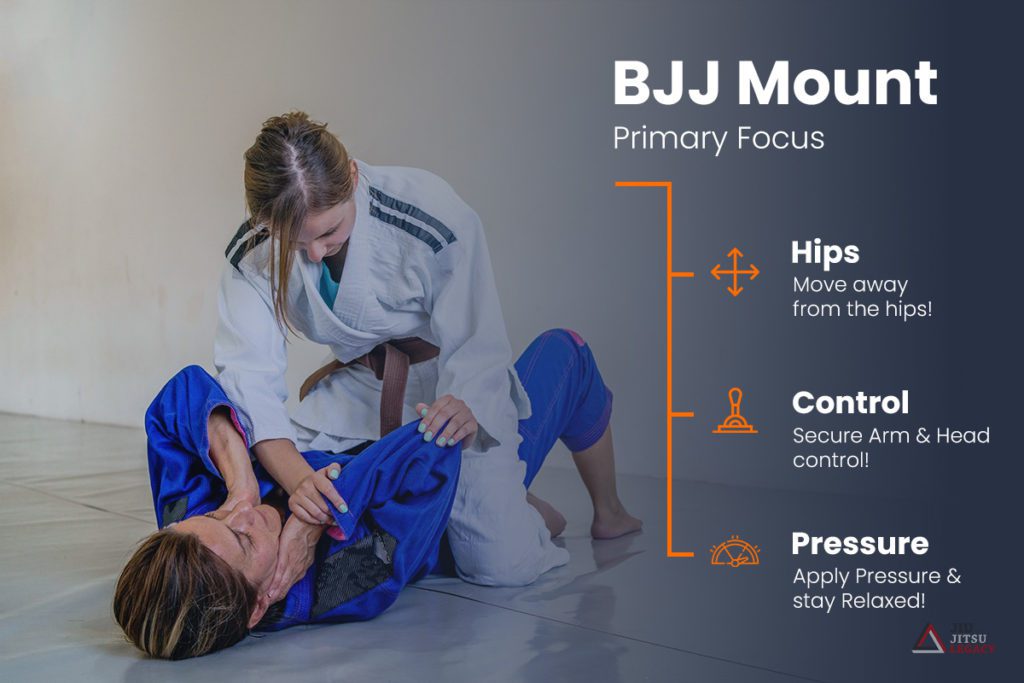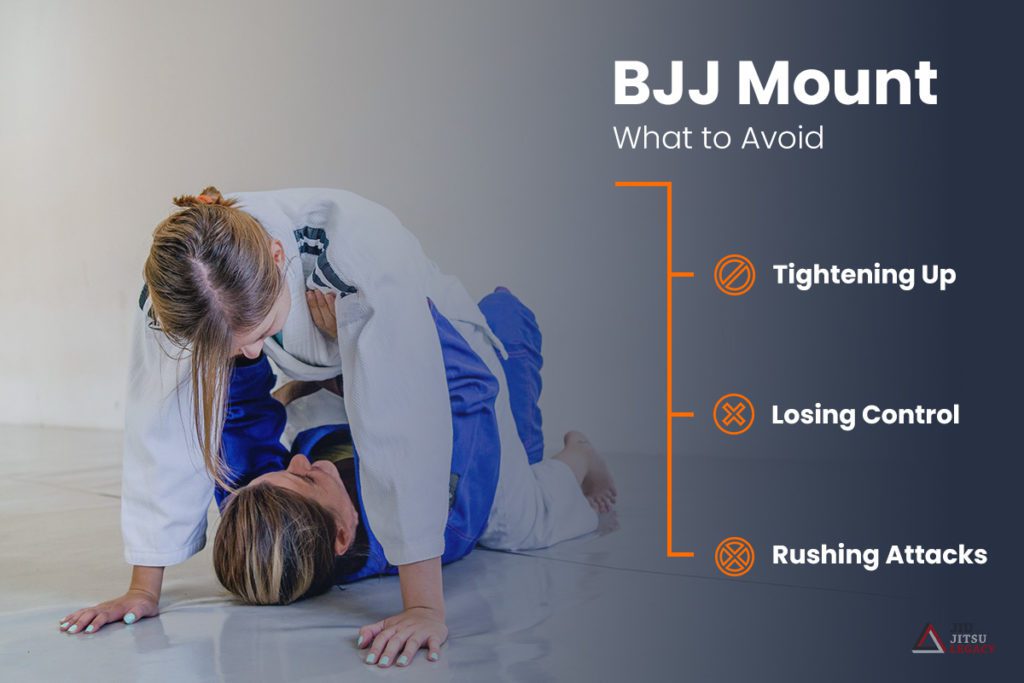Some call the full mount the king of positions in BJJ. While that title might be debatable, it is a fact that along with back control (also known as back mount) the mount position is where you want to be in grappling, MMA, and self-defense. However, many people ignore this crucial position, thinking it too difficult to maintain against a determined opponent.
Allow us to simplify the full mount for you – by following just three proven steps you will more easily dominate your opponents from this powerful position.
Why Is The Full Mount Position Important?
From a sports BJJ standpoint, the full mount earns the most points (4) that you can receive at once. It also provides you with ample control over your opponent and numerous ways in which to attack, all the while being perfectly safe from attacks yourself.
This safety aspect is very important in both MMA and self-defense scenarios. Finding yourself in a position where you can significantly harm your opponent (punching, elbow strikes, and submissions) while they can’t threaten is as good as it gets.
No matter which way you look at it the Jiu Jitsu mount is where you want to be – as long as you are the one on top!
So, what’s the catch? Why isn’t everyone in BJJ and MMA just going to the mount and effortlessly cruising to victory?
The answer is that while the mount provides lots of options, there are also lots of ways to escape it. And, because of the position’s danger, people spend lots of time practicing these escapes. That means that in order to really be able to control the full mount position, you need to know how to effectively deny the bottom person their ability to mount a defense and or escape.
Key Elements of the BJJ Mount
For those that have no idea what the mount is, it is a position where one person (the defender) is lying supine on the ground, and the other person (the attacker) has their legs straddled around their waist from the top. Both the knees and the feet of the attacker are on the ground, making movement pretty difficult for the defender.
While this is clearly a dominant position, staying on top against someone who is bigger and stronger, and/or trained in grappling is no easy feat. Unless, of course, you have a solid understanding of what the key elements of the mount are, and how to obtain them.

Balance
When you are in the full mount position, the biggest threat to you losing the position is losing your balance. There are plenty of nuances we can talk about in terms of balance, but for the sake of simplicity, we’ll focus on posture.
When you end up in the mount position, there is absolutely no reason for you to stay upright. What you should aim to do the moment you find yourself on the mount is to lower your torso onto theirs. Even if you want to punch, you will start in this low position before you proceed to straighten up, throw your strikes, and then lower back down for control.
Without balance, you have no hope of staying in the mount, which, in turn, means you can’t set up any kind of meaningful attack.
Mobility
Mobility is a detail that most people miss. While pinning someone to the ground is your goal from the mount, there is no way you’re going to completely block the bottom person from moving. In fact, the more you try to keep them from moving, the more you’ll fail.
Instead, you should be thinking about constantly adjusting to their movements. Staying in mount for prolonged periods of time will require you to shift up and down, change your weight distribution, switch your grips, etc, all in response to how the bottom person is moving.
Control
Controlling someone from the mount means pinning them to the ground. Pinning someone in Jiu Jitsu is about not letting them move in specific directions, rather than not letting them move at all. From the mount, you want to prevent your opponent from bridging or shrimping, as these motions create space for defense.
Rather than trying to stop every motion your opponent makes, focus on preventing only those motions which will allow them to escape.
3 Steps to Dominating the Full Mount
Think of controlling someone in the Jiu Jitsu mount position as controlling a snake with your arms. The first thing to control is the snake’s head, preventing it from biting you. While this may be enough to gain control of it, you also want to grab near its tail to prevent it from coiling around your arm.
Ok, humans aren’t snakes, nor are they snake shaped, so the analogy breaks down when too closely examined. However, what this snake control analogy means for mount control is that if you want people in your mount to be powerless, you need to control their head and their hips.

1. Get Off The Power Source (move away from the hips)
The first order of business from mount is to get off the main power source – the hips. The hip line is very easy to recognize in Jiu Jitsu – it is the imaginary horizontal line running parallel to and just below the belt.
In the case of mount, keeping your hips over this line will allow the bottom person to use the power of the hips to create space and throw you over. Your efforts at keeping your balance will be a losing battle if you don’t neutralize the power of the hips.
Your first goal, once in the mount position, is to move away from the hip line. That means placing your hips at, or even better, above the opponent’s belt level. You have no hope of stopping the power of their hips directly, but getting away from them will take away most of the bridging power the defender has.
2. Make them Weak (arms over head)
Once you’re off the power line, it is time for the biggest battle of the Jiu Jitsu mount – arm and head control. However, it is not only about grabbing a crossface and putting pressure onto your opponent’s face. Yes, this will give you a certain amount of control over the head but it leaves their arms free to disrupt your position and create escaping opportunities.
What you want to do in order to make sure you can control an opponent from the mount position is make them weak. It is a lot easier to control someone when they’re weak rather than when they’re strong. The weakest position you can put someone in is with their arms over their head.
This means that once you beat the power of the hips, your next concern is taking at least one (preferably both) of the opponent’s elbows above their shoulders and if possible, over their head. Underhooks are the best way to achieve this.
This will make them very weak and allow you to control their head directly by making them turn their face to one side using your shoulders, head, or grips. You can be as creative as you want as long as you have both their arms above their head, and their head facing in a direction of your choosing.
3. Create Pressure (remember to relax!)
Taking the power of the hips away kills bridge escapes from the Jiu Jitsu mount positions. Making the opponent weak by opening their elbows and turning their head takes away hip escapes and other frame-based escapes. What is left now is to put the bottom person under so much pressure they don’t even think about escaping.
As a coach, I’ve spent countless hours figuring out how to explain pressure to people. Luckily, in the case of the BJJ mount, there’s an easy way to do it. Namely, once you’re in position with steps 1 and 2, the final (and most difficult) thing to do is relax.
Let me be clear. When I say relax, I don’t mean let everything go and lose the position. I mean completely relaxing your muscles on top of your opponent, making them bear the full weight of your body while keeping the control you have over the head and arms.
The example I use when teaching is to have someone bigger than me bear hug me from behind and pick me off the ground. After they achieve it with ease, I ask them to do it again, but this time I relax my body completely. It becomes a lot more difficult, as my body is heavier when completely relaxed and it feels like they’re trying to lift a balloon filled with water.
Imagine how the person at the bottom of your Jiu Jitsu mount will feel when you relax all your weight on top of them like this, especially when their hips are powerless and their head and arms are under your control.
The most common analogy for this effect is “plank” versus “wet blanket.” It’s easy to move a plank (tense person) off of yourself, but hard to push a wet blanket (relaxed person) off of yourself.
Common Mistakes from the Top of Full Mount
It is not difficult to figure out the key elements of mount retention, or how to hone in on the most important one – control. However, as the defender inevitably starts to move around, attackers often end up making mistakes.

One mistake I see often is tightening up every muscle in your body the moment an opponent tries to move around. This will limit your control and your ability to effortlessly apply pressure, and your opponent can work backward to reverse engineer the steps of your control and eventually escape.
It will take time and drilling to be able to fully relax under pressure but once you overcome this common mistake, your Jiu Jitsu mount will improve significantly.
Another thing to keep in mind is keeping their arms above their head. It won’t always be possible to have both their arms up, but one arm and head control will suffice. Do not compromise what you’ve already gained in order to try and set up the perfect control. Rather, be patient and work slowly, not allowing the opponent any chance to disrupt your control.
Finally, remember that posturing up, even with all three steps of control in place, is not a good idea, because your balance will immediately suffer. When launching attacks you should minimize how much you disrupt your own base. Most people end up losing the mount by rushing an attack, putting themselves off balance and making space.
Conclusion
No matter what belt you are, start practicing this concept (and any new concept!) on white belts and work your way up. Whenever you get to the mount position, look for the key elements (balance, mobility, and control) and focus particularly on the three steps of dominant mount control (get off the power source/hips, make them weak/arms over their head, create pressure).
Once you can stay in mount for a full round against three different white belts, move on to blue belts and repeat the process. By the time you get to black belts, you’ll have removed most of the common mistakes from your game and have developed incredible full mount control.
Icons created by Freepik – Flaticon

Ogi is a black belt that does Jiu Jitsu full time and is very passionate about anything grappling-related.
He is also the head coach of Enso Jiu Jitsu in Macedonia and an aspiring Globetrotter.
